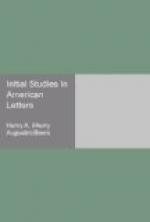To Concord also came Nathaniel Hawthorne, who took up his residence there first at the “Old Manse,” and afterward at “The Wayside.” Though naturally an idealist, he said that he came too late to Concord to fall decidedly under Emerson’s influence. Of that he would have stood in little danger even had he come earlier. He appreciated the deep and subtle quality of Emerson’s imagination, but his own shy genius always jealously guarded its independence and resented the too close approaches of an alien mind. Among the native disciples of Emerson at Concord the most noteworthy were Henry Thoreau, and his friend and biographer, William Ellery Channing, Jr., a nephew of the great Channing. Channing was a contributor to the Dial, and he published a volume of poems which elicited a fiercely contemptous review from Edgar Poe. Though disfigured by affectation and obscurity, many of Channing’s verses were distinguished by true poetic feeling, and the last line of his little piece, A Poet’s Hope,
“If my bark sink ’tis to another sea,”
has taken a permanent place in the literature of transcendentalism.
The private organ of the transcendentalists was the Dial, a quarterly magazine, published from 1840 to 1844, and edited by Emerson and Margaret Fuller. Among its contributors, besides those already mentioned, were Ripley, Thoreau, Parker, James Freeman Clarke, Charles A. Dana, John S. Dwight, C. P. Cranch, Charles Emerson, and William H. Channing, another nephew of Dr. Channing. It contained, along with a good deal of rubbish, some of the best poetry and prose that has been published in America. The most lasting part of its contents were the contributions of Emerson and Thoreau. But even as a whole it was a unique way-mark in the history of our literature.




